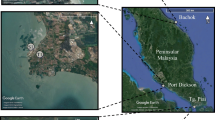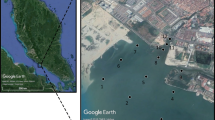Abstract
This study aims to determine the concentrations of surfactants on the sea-surface microlayer and in atmospheric aerosols from several coastal areas along the Malacca Straits. The concentrations of surfactants from the sea-surface microlayer (collected using rotation drum) and aerosols (collected using HVS) were analysed as Methylene Blue Active Substances (MBAS) and Disulphine Blue Active Substances (DBAS) by colorimetric method using a UV–visible spectrophotometer. The results of this study show the average concentrations of surfactants in the sea-surface microlayer ranged between undetected and 0.36 ± 0.34 μmolL−1 for MBAS and between 0.11 ± 0.02 and 0.21 ± 0.13 μmolL−1 for DBAS. The contribution of surfactants from the sea-surface microlayer to the composition of surfactants in atmospheric aerosols appears to be more dominant in coarse mode aerosols. Other anthropogenic sources such as regional biomass burning can also contribute to the amount of atmospheric surfactants as MBAS.
Access provided by Autonomous University of Puebla. Download conference paper PDF
Similar content being viewed by others
Keywords
Highlights
-
Anionic surfactants dominated the concentration of surfactants.
-
Surfactants in SML were contributed by anthropogenic sources.
-
Biomass burning and sea spray are the main sources of atmospheric surfactants.
Introduction
Surface active substances or surfactants in sea-surface microlayer (SML) play important role on solubility and fate of chemicals in marine environment. Surfactants molecules reducing the surface tension of the water–air interface (Wurl et al. 2011; Lechtenfeld et al. 2013). Microorganism such as phytoplankton has been recognized as major contributor to the amount of surfactants naturally. The development and waste generation along the coastal areas has contributed to the high amount of surfactants from anthropogenic sources (Roslan et al. 2010). Evaporation processes from sea-surface microlayer will lead to the high amount of surfactants in marine aerosols along the coastal area. Surfactants in atmospheric aerosols can behave as cloud condensation nuclei (CNN) which can profoundly impact cloud properties, with important effects on local and global climate (Sareen et al. 2013).
This manuscript aims to determine the concentration of surfactants in sea-surface microlayer and surfactants in atmospheric aerosols along the busy coastal area of Malacca Straits. Using the Principal Component Analysis and Multiple Linear Regression (PCA-MLR) through the composition of anion and cation, the source apportionment of surfactants in atmospheric aerosols will be determined.
Materials and Methods
Sampling Site and Sea-Surface Microlayer
Samples of the sea-surface microlayer (SML) and atmospheric aerosols were collected between October 2011 and Mac 2013 from six locations with different background along the Malacca Straits. These sites namely Bayan Lepas (Penang), Kuala Selangor (Selangor), Port Dickson (Negeri Sembilan), Muar (Johor), Pontian (Johor) and Tanjung Piai (Johor).
Samples from SML were collected using a glass rotation drum as suggested by Harvey (1966). The surface collector uses a smooth, rotating cylinder whose surface is readily wet by water. Samples were stored in a vial at 4 °C prior to surfactant analysis.
Fine and Coarse Mode Aerosols
Samples from marine aerosol were also collected at each sampling stations. The samples were collected using a high volume sampler (HVS) (Thermo Scientific Model GS2313-105) in combination with a two-stage Cascade Impactor (Staplex) with slotted filter paper (Westech Instrument) to collect coarse mode aerosols (diameter size > 1.5 μm) and backup filter paper (Whatman EPM 2000) to collect fine mode aerosols (diameter size < 1.5 μm).
The sea-surface microlayer samples were filtered using 0.45 μm Whatman GF/C glass microfibre filters; the filtration process was conducted in the clean room. Then 20 mL of filtered samples were put into a 40 mL vial for surfactant analysis. For the aerosol samples, the filter paper containing aerosol particles was cut into small pieces (1 × 1 cm) in the laminar flow chamber (clean air station) before being extracted with 50 mL de-ionized water using ultrasonic extraction (Branson 3510, USA). The samples were then filtered using Whatman 0.45 μm GF/C glass microfibre filters and a vacuum pump (850 Air Compressor). Each 20 mL filtered sample was put into a 40 mL vial, ready for surfactant analysis. Blank filter papers for both coarse and fine mode aerosols were treated in the same way as the aerosol samples filter papers.
Surfactant Analytical and Statistical Analyses
The analytical method for both anionic and cationic surfactants is based on the formation of ion-association complex between the anionic or cationic surfactants and cationic (disulfine blue) or anionic (methylene blue) dyes, followed by spectrophotometric measurement of the intensity of the extracted coloured complex as applied by Latif and Brimblecombe (2004).
The concentrations of surfactants as MBAS were measured using the calibration curve established using sodium dodecyl sulphate (SDS) at the range of 0.05–2.00 μmol/L while the concentration of cationic surfactants as DBAS were measured using the calibration curve established using benzyl-dimethyl-tetradecyl-ammonium chloride dehydrate or Zephiramine at the range of 0.04–2.00 μmol/L for (DBAS) surfactants. Preliminary source identification study of surfactants using ionic compositions (F−, Cl−, NO3 −, SO4 2−, K+, Mg2+, Ca2+) was carried out using Principle Component Analysis (PCA) together with multiple linear regression (MLR).
Results and Discussion
Surfactant in the Sea-Surface Microlayer
The concentrations of both anionic and cationic surfactants collected from the SML from the sampling stations are summarised in Table 80.1. Overall, the concentrations of anionic surfactants as MBAS in the SML were recorded higher compare to cationic surfactants as DBAS. Stations near to the river and urban areas show higher concentration of surfactants. There is no significant correlation (p > 0.05) between DBAS and MBAS in sea-surface microlayer.
The concentrations of both anionic and cationic surfactants from the aerosol samples are summarised in Table 80.2. The concentrations of anionic surfactants as MBAS were recorded higher compare to cationic surfactants as DBAS particularly at the station which influence by industrial activities such as Bayan Lepas.
PCA-MLR analysis using atmospheric aerosols major ions composition shows that the anionic surfactants as MBAS in fine mode aerosols are more related to anthropogenic sources such as biomass burning. Meanwhile, the composition of surfactants as MBAS in coarse mode aerosols and DBAS in both fine and coarse mode aerosols were related to sea spray.
Conclusion
This study shows that the concentrations of surfactants in sea-surface microlayer are more related to anthropogenic sources particularly from river water intrusion. The composition of surfactants in atmospheric aerosols can be contributed by various sources. Regional biomass burning can contribute to the amount of anionic surfactants as MBAS in fine mode aerosols. On the other hand, concentration of anionic surfactants as MBAS and cationic surfactants as DBAS (in fine and coarse mode) are still influence by sea spray. Generation of surfactants in atmospheric aerosols from sea-surface microlayer can be eliminated with lower amount of surfactants especially from anthropogenic sources going into coastal areas.
References
Harvey GW (1966) Microlayer collection from the sea surface: A new method and initial results. App Oceano 11:608–613
Latif MT, Brimblecombe P (2004) Surfactants in atmospheric aerosols. Environ Sci Technol 38:6501–6506
Lechtenfeld OJ, Koch BP, Gašparović B, Frka S, Witt M, Kattner G (2013) The influence of salinity on the molecular and optical properties of surface microlayers in a karstic estuary. Mar Chem 150:25–38
Roslan RN, Hanif NM, Othman MR, Azmi WN, Yan XX, Ali MM, Mohamed CA, Latif MT (2010) Surfactants in the sea-surface microlayer and their contribution to atmospheric aerosols around coastal areas of the Malaysian peninsula. Mar Pollut Bull 60:1584–1590
Sareen N, Schwier AN, Lathem TL, Nenes A and McNeill VF (2013) Surfactants from the gas phase may promote cloud droplet formation. Proc Natl Acad Sci USA 110:2723–2728
Wurl O, Wurl E, Miller L, Johnson K, Vagle S (2011) Formation and global distribution of sea-surface microlayers. Biogeosci 8:121–135
Author information
Authors and Affiliations
Corresponding author
Editor information
Editors and Affiliations
Rights and permissions
Copyright information
© 2014 Springer Science+Business Media Singapore
About this paper
Cite this paper
Latif, M.T. et al. (2014). Composition of Surfactants from Sea-Surface Microlayer and Marine Aerosols along the Malacca Straits. In: Aris, A., Tengku Ismail, T., Harun, R., Abdullah, A., Ishak, M. (eds) From Sources to Solution. Springer, Singapore. https://doi.org/10.1007/978-981-4560-70-2_80
Download citation
DOI: https://doi.org/10.1007/978-981-4560-70-2_80
Published:
Publisher Name: Springer, Singapore
Print ISBN: 978-981-4560-69-6
Online ISBN: 978-981-4560-70-2
eBook Packages: Earth and Environmental ScienceEarth and Environmental Science (R0)




